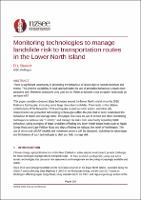| dc.contributor.author | Stewart, David | |
| dc.date.accessioned | 2023-02-21T01:18:16Z | |
| dc.date.available | 2023-02-21T01:18:16Z | |
| dc.date.issued | 2022-04-27 | |
| dc.identifier.uri | https://repo.nzsee.org.nz/xmlui/handle/nzsee/2506 | |
| dc.description.abstract | There is significant uncertainty in predicting the behaviour of slopes due to natural processes and events. The inherent variability in rock and soil make the use of precedent behavior a much more attractive tool. However, precedent only goes so far. When precedent is not an option what tools do we have left?
This paper considers observed slope behaviour around the lower North Island since the 2016 Kaikoura Earthquake, including some large disruptive landslides. Comments on the relative contributions of the November 2016 earthquake as well as storm events, and other site characteristics will be presented. Monitoring technologies offers the potential to better understand the behaviour of slopes and manage risks. This paper discusses the use of drones and other monitoring techniques to improve site ‘visibility’ and manage the risks from uncertainty regarding slope behaviour, using examples of large landslides affecting key roads such as Ngaio Gorge Road and Cape Palliser Road and debris flows affecting the railway line north of Wellington. The use of drone and LiDAR models and movement sensors will be discussed, including the advantages and limitations of such technologies to alert and help manage risk. | |
| dc.language.iso | en | |
| dc.publisher | New Zealand Society for Earthquake Engineering | |
| dc.relation.ispartofseries | 2022;134 | |
| dc.subject | Digital and emerging technologies | |
| dc.title | Monitoring technologies to manage landslide risk to transportation routes in the Lower North Island | |
| dc.type | Article | |

